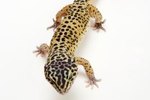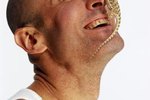
Hiccups are uncontrollable spasms that occur in the diaphragm muscle in humans and other mammals. The closing of a part of the vocal cords causes the characteristic "hic" sound. In most cases, hiccups are not serious medical concerns and they eventually go away on their own. That said, hiccuplike behavior in companion animals can be troubling for an owner. Bearded dragons are captive pets who do not possess movable diaphragm muscles and, as such, cannot hiccup. Other behaviors of the bearded dragon, though, such as mating calls and threat displays, can appear to be hiccups.
Head Bobbing
The behavior of the bearded dragon most similar to the mammal hiccup is known as head bobbing or head jerking. This behavior involves the beardy lowering his head and jerking it upward. This action can be subtle or it can be violent enough to jerk the entire front part of the lizard's body upward. Head bobbing is an extremely common courtship behavior among male bearded dragons, even when no females are present.
Panting During Basking
Reptiles like the bearded dragon are cold-blooded; they require periods of basking in a warm place to raise their body temperatures. Beardies have been known to hold their mouths open while basking to help fine-tune their temperatures, occasionally also panting. This panting may be quick and may be mistaken for hiccups. A healthy bearded dragon must be offered a temperature gradient in his enclosure, so they he can self-thermoregulate freely. A dragon who lacks the gradient and is overheated may pant constantly.
Open Mouth Display
The bearded dragon is named for the flap of skin on the underside of the jaw that he can inflate with air to appear larger and scare off incoming predators and other threats. When inflated, it looks like the dragon has a large, dark beard. The open mouth display is a common defense that most beardies who aren't used to being handled or being around humans will initiate. They open their mouth and rapidly inflate their beards. If done in succession, this behavior can resemble hiccuping.
Respiratory Infection Behaviors
Like all reptiles, proper care and housing is essential to maintaining a happy and healthy bearded dragon. Even with the best care, beardies will sometimes get sick. Respiratory infections are not uncommon. Mouth gaping and forced exhalation are signs of respiratory infection that should be immediately followed up with a veterinarian visit if the reptile displays any other symptoms, as reptiles are usually very good at hiding illnesses until they are severe.
References
Photo Credits
-
BananaStock/BananaStock/Getty Images



